
Furnitur Maker David Turbridge.
David Trubridge is the antithesis of those rock-star product designers who turn up at "design art" auctions in New York City or in the front row of Paris fashion shows. In contrast, this rather shaggy 57-year-old British-born New Zealander is a fixture on the lecture circuit, where he is a passionate advocate for sustainability and responsibility. When it comes to his own work, however, he prefers to let it do the talking.
When Kate Moss launched the first of her Topshop collections, the London store was illuminated through the vast honeycomb-cut plywood lampshades of Trubridge's Coral design, as were the store windows of Printemps in Paris earlier this year, where the lampshades were featured alongside fashions from Lanvin and Stella McCartney. Ergonomic, sculptural seats made of steam-pressed wooden batons could easily grace the smart homes displayed in shelter magazines. While these and other Trubridge creations are an annual attraction at Milan's Salone Internazionale del Mobile, they begin in a rural winegrowing region that is off the beaten track, even by New Zealand standards; the designer develops his ideas in a garden shed. (It would be an exaggeration to call it a studio.)
"I've never claimed any of my stuff is art, and I never will," states Trubridge. This despite "Spiral Islands," an installation of lighting and seating fixtures that reflect the way clouds float above landmasses. They're being snapped up by collectors who may not care — although it is vital to their creator — that everything in their manufacture is sustainable, from the wood derived from managed plantations to the hydroelectricity.
Trubridge's creations — some made in New Zealand, others produced by the Italian manufacturer Cappellini — sell at such hot spots as Ray20 in New York City's Tribeca, NuZi in Shanghai and Detail Inc. Japan in Tokyo. While they are not specifically branded as green, they certainly are — right down to Trubridge's rejection of the conventional furniture structure of upright posts joined by a horizontal beam; he favors domed structures, which can use far less material. He trained as a naval architect and once worked as a forester, but his breakthrough came in 2001 with the Body Raft, a steamed-bentwood seat, still a top seller, that represented a marriage of handcraftsmanship and computer-aided design. Trubridge is of a generation trained at the drawing board, and although he has taken naturally to the computer, his talent still lies in his hands. "I've got years of experience bending, breaking bits of wood, joining them together," he says. "You have to be able to make things in reality.